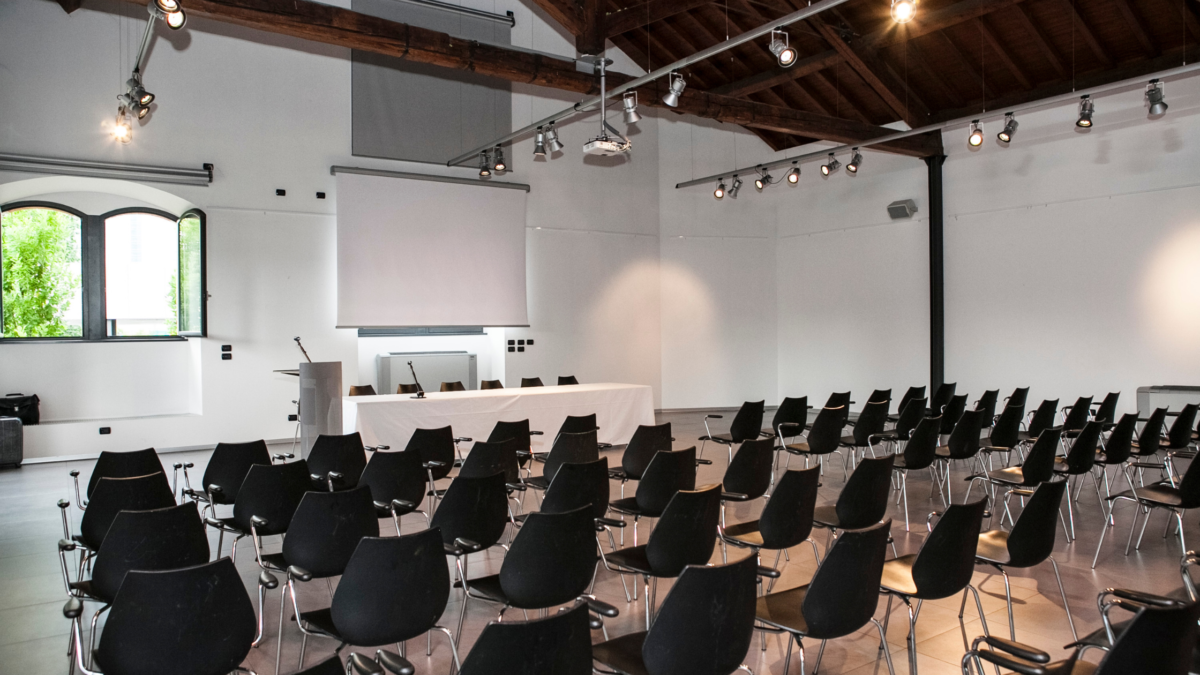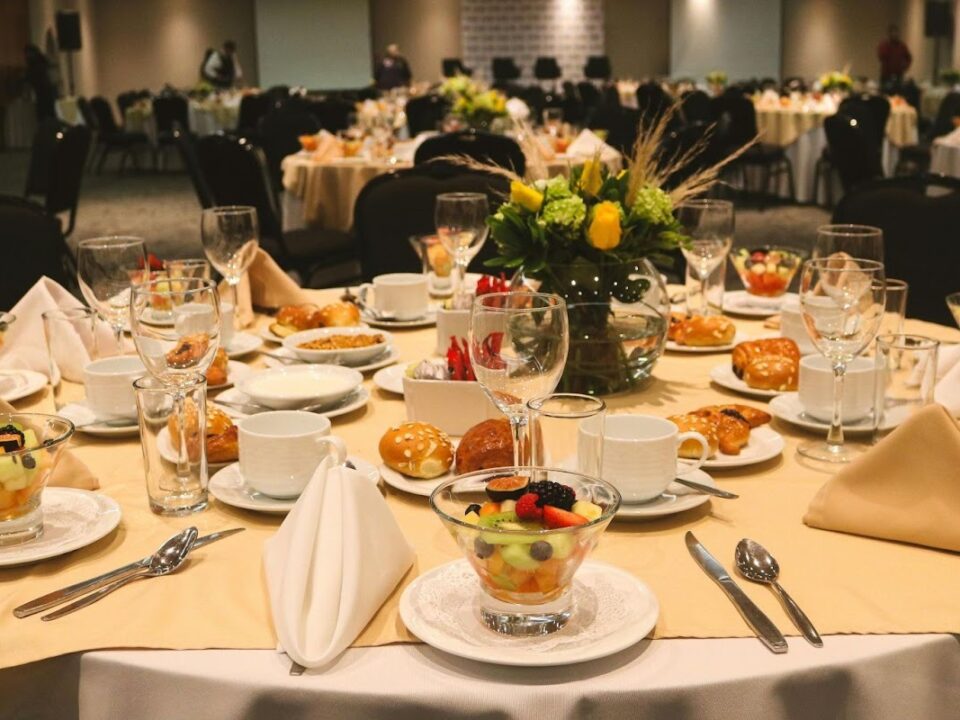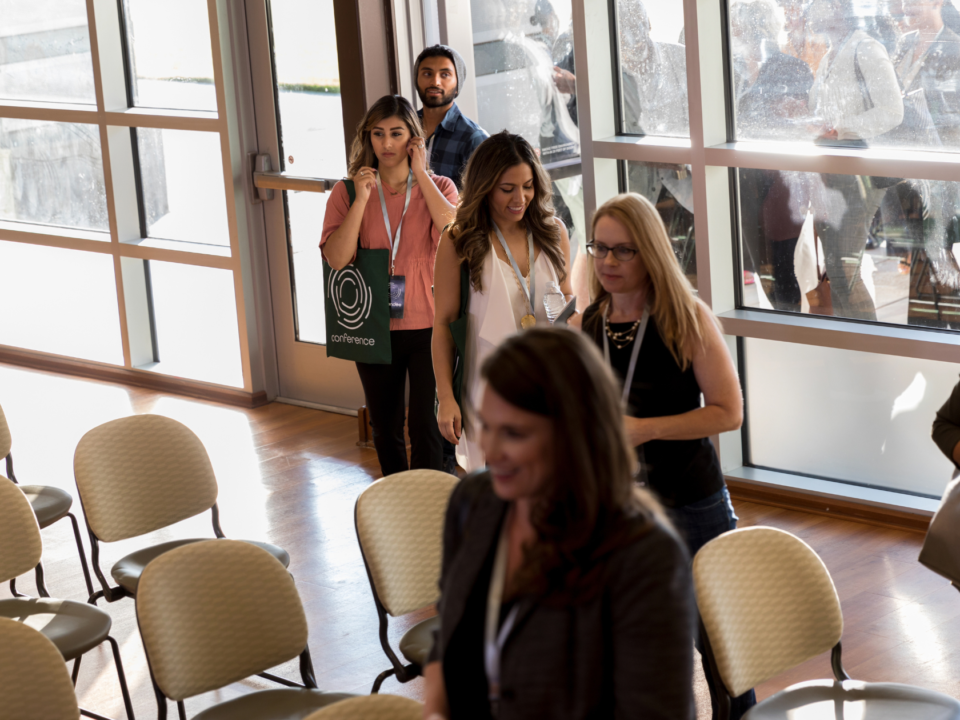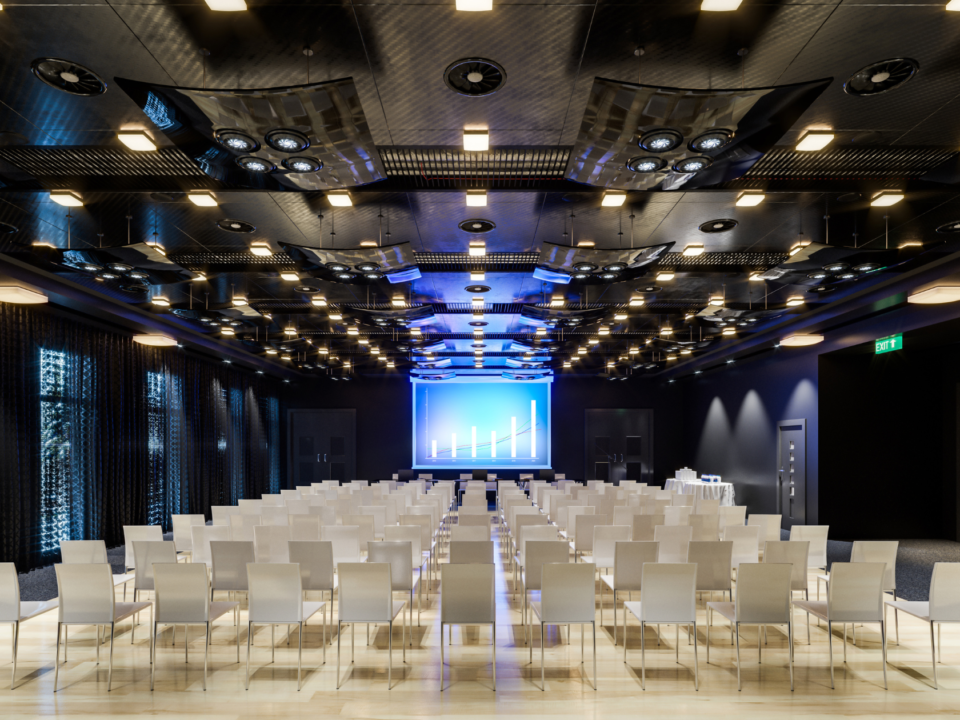Planning a Business Event? Find the Ideal Conference Venue NYC Has to Offer

Top Features to Look for in a Corporate Training Space Manhattan Professionals Prefer
July 22, 2025
Why a Conference Venue in Midtown Manhattan Is Perfect for Your Next Meeting?
July 22, 2025Planning a business event in New York City is no small feat. In a city that thrives on ambition, speed, and high standards, your venue choice does more than just provide a location; it sends a message. Choosing the right conference venue in NYC means setting the tone for professionalism, purpose, and polish. Whether you’re organizing a leadership summit, an annual strategy session, a product launch, or a client-facing conference, your space becomes part of the story you’re telling.
New York professionals are busy, discerning, and used to seeing the best. If your venue isn’t up to par, if it’s hard to find, lacking in tech, or uncomfortable, it can distract from your goals before the event even starts. But the right venue? It sets the tone, encourages engagement, and elevates your message.
The challenge is: NYC offers hundreds of options, from iconic skyscrapers to tucked-away boutique spaces. So, how do you choose a venue that’s both impressive and practical? One that reflects your brand, fits your needs, and helps your event run without a hitch?
That’s what this guide is here to help with. We’re breaking down the must-have features that truly make a difference when selecting a conference venue in NYC. From location and layout to technology and service, we’ll help you cut through the noise and find a space that delivers real impact, because your business event deserves more than just four walls and a calendar slot.
Define Your Event Type and Goals
Before you start clicking through venue photos or reaching out to booking managers, pause and zoom in on what your event is really about. Every business event has a purpose, and understanding yours is the first step to making smart decisions that save time, money, and stress down the line.
So, what exactly are you planning? A leadership summit where C-suite executives need a quiet, polished space to focus on strategy? A product launch that needs a stage, screens, and lots of energy? A networking mixer that thrives on casual conversations and open floor plans? Each of these calls for a completely different vibe, and your venue needs to match.
Next, consider who’s in the room. Are you speaking to your internal team, employees, department heads, and board members? Or is this event outward-facing, with clients, industry partners, investors, or media involved? Internal events might allow for more flexibility or informality, while external ones usually require a higher level of polish and professionalism. Knowing your audience will guide you toward the right size, layout, ambiance, and amenities.
Think, too, about your brand personality. Are you aiming for luxury and elegance? Innovation and creativity? Classic professionalism? A bold, modern space with floor-to-ceiling windows might be great for a tech company unveiling a new platform. A historic venue with chandeliers and rich woodwork might better suit a financial firm’s investor gathering. Your venue becomes a physical expression of your brand, so don’t overlook the details.
Finally, clarify your goals for the day. What do you want your attendees to walk away with? Is it connections, knowledge, clarity, or momentum? If collaboration is your goal, prioritize venues with breakout spaces. If you’re presenting big ideas, you’ll want a central stage, A/V equipment, and tiered seating for visibility. If it’s a long day of training, comfort and flow matter most.
When you know your event type, who you’re talking to, and what you want to achieve, you’re far more equipped to pick a venue that not only fits, but actively enhances, the experience you’re trying to create.
Prioritize a Central, Accessible NYC Location
Your venue’s location says as much as your signage, maybe more. If your guests can’t find the place, struggle to get there, or arrive flustered by subway transfers, the day is already off to a rocky start. On the flip side, a central, easily accessible location does more than keep things on schedule; it sets a tone of professionalism, convenience, and care.
Midtown Manhattan is often the default for good reason. It’s the epicenter of the business world and incredibly well-connected. From Grand Central Terminal to Penn Station and Port Authority, your attendees can arrive via subway, commuter rail, or bus without needing to hike cross-borough or hop in a cab. For out-of-towners flying into JFK, LaGuardia, or Newark, the path is relatively direct and full of hotel options nearby.
But location isn’t just about transit, it’s about vibe and practicality. A venue within walking distance of coffee shops, restaurants, and hotels allows guests to grab breakfast before the first keynote, step out for a call between sessions, or meet a colleague for drinks after the event ends. That walkability adds flow and flexibility, especially for multi-day events or full schedules.
There’s also the psychology of location. People naturally associate central Manhattan venues with importance and professionalism. Hosting your event on or near Fifth Avenue, Bryant Park, Times Square, or Rockefeller Center sends a message: this event matters. It builds anticipation and adds credibility before you’ve even sent the invite.
And don’t forget that location impacts your team, too. If you’re bringing in internal staff or vendors to support the event, having everything centralized saves time, limits complications, and makes last-minute adjustments easier. It keeps everyone focused on what really matters, the success of the day.
Bottom line? In NYC, where time is money and first impressions are everything, choosing a conference venue in a central, accessible location isn’t just smart, it’s essential.
Look for Scalable, Flexible Spaces
A successful business event isn’t just about the guest list or the content; it’s about how the space works with your goals. Even the most compelling presentation can lose impact if the room feels cramped, too large, or just plain awkward. That’s why flexibility and scalability should be high on your list when choosing a conference venue in NYC.
Think beyond just one big conference room. Sure, you’ll need a spacious main area for keynotes or company-wide addresses, but your event will likely include multiple components, panel discussions, breakout workshops, private meetings, networking sessions, maybe even a post-event reception. You need a venue that offers a mix of room sizes and functions. Ideally, that means a central plenary room plus a selection of breakout spaces, lounges, and social areas that support the flow of your agenda.
Now let’s talk layout. No two sessions are the same. Some will require theater-style seating to maximize capacity for a keynote speaker. Others may benefit from roundtable setups for collaborative problem-solving or classroom-style arrangements for educational content. The best venues not only allow for these transitions, but they also make them easy, fast, and seamless. Movable furniture, room dividers, and modular layouts help you create exactly the environment you need, when you need it.
If your event runs across an entire day or multiple days, you may also want spaces that can adapt from daytime learning to evening celebration. A smart venue gives you access to rooms that can shift from business to social. Need to host a cocktail hour, awards dinner, or client appreciation reception after the main sessions? Being able to keep everything under one roof keeps your event professional, organized, and efficient.
And don’t forget, NYC is busy. Moving guests from one location to another midday is stressful and time-consuming. When you can transition from presentations to breakouts to dinner in the same venue, you remove logistical friction and create a smoother, more enjoyable experience for everyone.
In short, scalability and flexibility aren’t just nice-to-haves; they’re mission-critical for a successful NYC business event.
Focus on Audiovisual and Technology Support
In today’s corporate landscape, technology isn’t a bonus; it’s the backbone of your event. Whether you’re hosting a leadership summit, product launch, or industry panel, the AV setup has the power to make or break the experience. There’s nothing that deflates a room quite like a flickering projector, a mic that refuses to work, or Wi-Fi that suddenly cuts out. These are not minor annoyances; they’re momentum-killers that can throw your entire agenda off track.
That’s why one of the most important things to look for in a conference venue in NYC is a fully integrated audiovisual infrastructure. We’re talking about crystal-clear microphones, ceiling-mounted speakers, HD projectors, large presentation screens, and adjustable lighting, all seamlessly connected and easy to use. This ensures your speakers can deliver confidently, your audience can stay focused, and your presentations look polished from start to finish.
If your event includes virtual attendees or a hybrid format, this is even more critical. Make sure the venue offers livestreaming capabilities with built-in cameras, high-quality audio systems, and platforms that support remote interaction. It should be just as easy for someone in California or London to join the conversation as it is for someone sitting in the front row. Hybrid meetings are now standard, and your venue should be ready to deliver a top-tier experience for both in-person and virtual participants.
And let’s talk Wi-Fi. Not just “available,” but strong, reliable, high-speed internet that doesn’t buckle under pressure. Your attendees will likely be using multiple devices, engaging with apps, downloading agendas, participating in live polls, or taking notes on shared documents. The last thing you want is for connectivity issues to derail your momentum. Be sure to test the venue’s bandwidth or ask for specs that confirm it can handle your headcount and event demands.
But even the best systems need a safety net, and that’s where on-site tech support comes in. Ask if there’s a dedicated technician on-site throughout the event, someone who can troubleshoot in real time, reset a projector in seconds, or swap out a mic without disrupting the flow. When things go wrong, and they sometimes do, it’s the speed and professionalism of the response that matters most.
Because at the end of the day, your job isn’t to run cables or diagnose audio issues. It’s to lead a successful event. And a venue that understands that makes your work easier, and your event more impactful.
Choose a Venue with On-Site Planning Support
Planning a business event in NYC can get overwhelming fast. Between scheduling speakers, coordinating vendors, and managing last-minute changes, even the most experienced event organizer can feel the pressure. That’s why having on-site planning support isn’t just helpful, it’s essential.
The best conference venues come with something better than beautiful rooms: they come with a dedicated event coordinator who knows the space, understands corporate expectations, and has handled every curveball in the book. These are the behind-the-scenes pros who keep your day running on time, your vendors on track, and your guests feeling like everything’s under control (even when you’re juggling a dozen moving parts).
What does that support look like? It starts well before your event even begins. A great planner will walk you through room layout options, confirm tech and seating arrangements, coordinate delivery times with caterers, and ensure your signage, materials, and registration desk are exactly where they need to be. They’ll help you fine-tune the timing so that transitions between sessions, meals, and networking breaks feel seamless, not rushed or chaotic.
During the event itself, that coordinator becomes your go-to person. Need to switch rooms last-minute? Add extra chairs? Delay a session by 15 minutes to accommodate a keynote speaker running late? They’ve got you covered. It’s their job to solve problems before they escalate, and they’ve usually seen it all before.
And don’t underestimate the power of small touches, a well-run check-in desk, welcome signage that guides attendees effortlessly, speaker-ready areas where presenters can prep, backup cables, chargers, or even water bottles for panelists. These details might seem minor, but they’re the difference between an event that feels patched together and one that feels professionally produced.
Remember, your venue staff is often the first and last point of contact for your attendees. Their professionalism reflects on your brand. When everything flows smoothly, your guests remember your message, not the microphone delay or the missing extension cord. So don’t settle for a venue that just hands over the keys and leaves you to it.
Instead, choose a space where the staff feels like part of your team, one that supports you from day one to final teardown. Because when you’re planning a business event in a city as fast-paced as New York, having an experienced, responsive partner on your side makes all the difference.
Consider Comfort, Aesthetics, and Atmosphere
The environment of your conference isn’t just decor; it sets the tone. Before a single speaker begins or a PowerPoint lights up the screen, your venue starts telling a story. It tells your guests whether they’re in for a professional, thoughtful experience or whether they should lower their expectations. In a city like New York, where impressions matter and attention is scarce, your atmosphere needs to work just as hard as your agenda.
Start with comfort. If attendees are seated in stiff chairs, squinting at a dimly lit stage, or shivering under a cold vent, they won’t be focused on your keynote; they’ll be checking their watches. Opt for ergonomic seating, spacious tables, and room layouts that give everyone a clear view. Make sure the space doesn’t feel overcrowded or isolating. A good conference venue should offer a layout that fosters both focus and interaction.
Then look at lighting and acoustics. Natural light is energizing; harsh fluorescent bulbs are not. A room bathed in daylight (with adjustable shades for screen presentations) instantly feels more inviting. Likewise, clear acoustics are a must; your speakers should be heard easily in every corner, without echoes or background noise from street traffic or adjacent events. Don’t underestimate the importance of soundproofing, especially in multi-room venues.
Climate control is essential. Your event might run all day or span multiple sessions. You need a space that maintains a comfortable temperature throughout, cool enough to stay alert but warm enough to avoid complaints. Good ventilation is also key, especially post-pandemic, when indoor air quality is top of mind.
And of course, aesthetics matter. This doesn’t mean chandeliers and marble floors, unless that fits your brand. But whether your company leans toward sleek modern minimalism, upscale elegance, or creative vibrancy, your venue should reflect that tone. When a space visually supports your brand identity, everything feels more intentional and cohesive, from signage and swag to speaker slides.
Even small touches, artwork on the walls, clean finishes, fresh flowers, and branded elements, can elevate the experience. You want your attendees to feel like the event was curated with care, not cobbled together at the last minute.
Because when people walk into a space that feels inspiring and professional, they’re more open to connection, more engaged in conversation, and more invested in the experience you’ve planned for them.
Catering and Refreshment Options Matter
Here’s the truth about business events: hungry people don’t focus, and thirsty people don’t linger. If your goal is engagement, energy, and a memorable experience, food and drink aren’t just a detail; they’re a strategy.
The best NYC conference venues understand this and either offer in-house catering or maintain strong partnerships with top-tier local vendors. This means less hassle for you and higher quality for your guests. Whether you’re planning a morning seminar with pastries and fresh coffee, a full buffet lunch, or a post-event cocktail hour, the venue should make it seamless to deliver meals that are timely, fresh, and beautifully presented.
Start with the essentials. A continuous coffee station, cold water, hot tea, and light snacks help keep people alert and present throughout the day. These refreshment areas also double as natural networking hubs, giving attendees a chance to mingle, decompress, and build relationships between sessions.
For larger events, make sure your venue includes a dedicated dining space or lounge. This keeps the event flowing smoothly; there’s nothing more awkward than trying to eat a boxed lunch at a standing-room-only table. A defined eating area also gives people a mental reset, helping them return to the next session refreshed and ready to engage.
Now let’s talk dietary needs. This is non-negotiable. Your catering partner must be able to accommodate a range of preferences and restrictions: gluten-free, vegetarian, vegan, kosher, halal, nut-free, and more. Inclusivity in food service isn’t just a trend; it’s a professional expectation. Ask upfront about menus and flexibility, and make sure you can gather dietary preferences during registration.
And don’t forget about presentation. A great meal loses its magic if it’s served on flimsy paper plates or scattered across a cluttered table. Look for venues that take food service seriously, whether it’s white-linen elegance for a formal dinner or clean, stylish setups for buffet lines and boxed meals.
Finally, consider how food and drink tie into your event flow. Is there room for a welcome breakfast? A midday networking lunch? An end-of-day reception with wine and light bites? These aren’t just meals, they’re moments that create shared memories, spark new connections, and make your event more than just a schedule of speakers.
Because in the end, people may forget a PowerPoint slide, but they’ll remember a delicious lunch, a great coffee chat, or a glass of wine that led to a new partnership. And that’s the kind of impact thoughtful catering can deliver.
Don’t Forget Breakout and Networking Areas
Business events are more than agendas and presentations; they’re about people connecting with people. Some of the most meaningful outcomes of a conference don’t happen in front of a projector screen; they happen in the side conversations, the chance encounters near the coffee station, or the impromptu brainstorming that starts over lunch. That’s why your venue needs to go beyond the stage and create space for human interaction.
A strong NYC conference venue should include dedicated breakout rooms for small-group discussions or deep-dive workshops. These rooms offer the flexibility to break up your programming with targeted sessions, ideal for departments working through strategy, client teams ideating on deliverables, or panelists regrouping after a mainstage Q&A. Bonus if they’re close to the main room for easy transitions between sessions.
But not every connection happens in a formal setting. Look for open lounges, quiet corners, or rooftop patios that give attendees room to breathe. These aren’t just “nice to have” features; they’re where the magic happens. When professionals get a chance to unwind, strike up a casual chat, or sit with a colleague to process what they’ve learned, it makes the event feel more personal and more productive.
Even if your schedule doesn’t include a formal networking hour, your space should encourage informal connections. Strategically placed high-top tables, coffee bars, or cozy seating arrangements offer those natural pause points where conversations start and ideas flow. If your venue makes people feel relaxed and unhurried between sessions, it makes everything about the day feel smoother and more enjoyable.
And for VIPs or key stakeholders, having semi-private meeting areas allows for sensitive conversations or quick business check-ins that require discretion. It shows you’ve thought through the event from every angle, not just from the front of the room.
In short, don’t let all your planning energy go into the main stage and forget what happens around it. A venue that gives people room to connect, decompress, and collaborate adds value that goes far beyond the official itinerary. And in New York City’s high-energy event scene, that kind of balance is exactly what your attendees will remember.
Accessibility, Cleanliness, and Safety
When someone walks into your event, they shouldn’t have to think about whether they can access the room, whether it feels clean, or whether they’ll be safe if something unexpected happens. These aren’t just logistical details; they’re the foundation of a professional, inclusive, and well-run experience.
Let’s start with accessibility. Your NYC venue must be fully ADA-compliant, with elevators to every floor, wide doorways and hallways, accessible restrooms, and clearly marked signage that helps guests of all abilities navigate the space independently. This isn’t a bonus, it’s a basic standard. But not every space in Manhattan gets this right, especially older buildings. Always ask during your walkthrough.
Beyond physical access, a good venue should have on-site staff who are trained to assist with various needs, whether that’s helping someone with mobility challenges, providing visual or auditory support, or just ensuring seating is arranged to accommodate service animals or assistive devices.
Next up: cleanliness. In a post-pandemic world, your guests are more aware than ever of how a space looks and feels in terms of sanitation. Make sure your venue follows visible, consistent cleaning practices throughout the day, especially in high-touch areas like restrooms, door handles, shared equipment, and dining areas.
You should see things like hand sanitizing stations, staff wiping down surfaces regularly, and trash areas that are emptied discreetly and often. If your venue can’t commit to a clean, hygienic environment, it’s a dealbreaker.
And of course, we can’t talk about safety without discussing emergency preparedness. Confirm that the venue has clearly marked emergency exits, up-to-date safety signage, and staff on hand who know how to respond to fire alarms, medical incidents, or building evacuations. It’s even better if they’ve walked you through these procedures as part of their onboarding, because that means they’re prepared and proactive.
Ask if there’s security on-site during your event. While most corporate conferences don’t require heavy-duty security, it’s comforting to know that someone is monitoring the entrance, watching over guest flow, and available if something unexpected occurs.
At the end of the day, your attendees are entrusting you with their time, and in some ways, their well-being. When your venue shows they take accessibility, cleanliness, and safety seriously, it sends a clear message: you care about your guests, not just your agenda. And that kind of care translates into stronger engagement, better reviews, and a deeper sense of connection to your brand.
Transparency in Pricing and Packages
In a city as competitive and event-savvy as New York, reputation isn’t just important, it’s everything. When you’re planning a business event, choosing the right conference venue isn’t just about glossy photos or polished websites. What truly matters is how the space performs under pressure, and for that, you need to look beyond the brochure and into the real-world experiences of others.
Start your research with online reviews from reputable platforms like Google, Yelp, LinkedIn, or event-focused directories such as Cvent and Peerspace. But don’t just skim the star ratings, go deeper. Read the content of the reviews to find consistent patterns. Did past clients mention that the staff was helpful and responsive? Were AV systems reliable, and tech support quick to step in? Was the venue clean, comfortable, and exactly as described? Most importantly, how did the venue handle unexpected situations or last-minute changes? These are the moments that define a venue’s true professionalism.
If you see the same compliments pop up, like praise for smooth coordination, great food, or a supportive planning team, that’s a great sign. On the other hand, if reviews consistently mention technical difficulties, poor communication, or subpar facilities, take those concerns seriously. One bad review can be an off day, but several? That’s a trend.
For even more confidence, go ahead and ask the venue directly for references. A reputable space should be glad to connect you with past clients, share event photos, or provide a brief case study of a similar event they’ve hosted. These first-hand insights give you a realistic understanding of how the venue handles business events like yours, from setup to execution.
And here’s a tip: if a venue hesitates when you ask for references or seems evasive about showing past work, it may be a red flag. A well-run, reliable venue should have nothing to hide and plenty to show off.
At the end of the day, booking a conference venue is about more than just square footage; it’s about trust. You’re handing over your guest experience, your schedule, and a piece of your brand reputation. Doing your homework, through thorough review checks, reference calls, and even event walkthroughs, ensures your venue is ready to deliver at your level. And in NYC, that’s the kind of confidence you need.
Check Reviews and Ask for References
In a city like New York, where business events happen daily, reputation isn’t just a bonus; it’s a necessity. Before you sign anything, take the time to dig into what other professionals are saying about the venue you’re considering. Online reviews are your best friend here, offering unfiltered insights that marketing materials can’t match. Platforms like Google, Yelp, and LinkedIn are a good place to start, but if you’re using event-specific directories like Cvent or Peerspace, be sure to check those as well.
What should you be looking for? Focus less on the overall rating and more on specific feedback. Are reviewers consistently praising the professionalism of the staff? Do they mention how quickly the team responded to issues or how smooth the AV and tech setup was? Did the cleanliness and ambiance meet or exceed expectations? These repeated themes are clues about the venue’s consistency and attention to detail.
Likewise, be alert for red flags. Multiple comments about slow communication, dirty restrooms, or unreliable tech shouldn’t be taken lightly. Patterns, good or bad, tend to reflect the truth.
Don’t stop at reviews. Ask the venue directly for references, ideally from recent clients who hosted events similar in size and scope to yours. A solid venue should be more than willing to provide testimonials, event photos, or even arrange a quick chat with a previous client. Seeing real-world examples of how they handle corporate gatherings helps you picture how your own event will unfold. If they’re hesitant to share references or past work, consider it a potential warning sign.
At the end of the day, your venue plays a direct role in your event’s success. When you check reviews and speak to others who’ve been in your shoes, you gain clarity, confidence, and peace of mind, all of which are priceless when the stakes are high.
Add-On Options to Enhance the Experience
A great event doesn’t stop at the basics. Once you’ve covered the essentials, like location, layout, and tech, look for ways to add personality and polish with customizable extras. These little touches can make your event feel less like a meeting and more like a full experience.
Start with the practical enhancements. A coat check might seem small, but it instantly adds convenience, especially during cooler months. Branded signage or digital welcome screens can help guests navigate the venue while reinforcing your company’s identity. Mobile charging stations are always appreciated, particularly at full-day events where phones and laptops are in constant use. You might also consider printing and copying stations for last-minute handouts or agenda changes.
For a more elevated experience, think about wellness-focused add-ons. Can you offer on-site yoga, meditation breaks, or even quiet zones where attendees can decompress between sessions? These options go a long way in showing you care about more than just business; you’re creating a thoughtful, human-centered environment.
Planning a longer event? Ask about options for pre-conference breakfasts, midday lunch service, or post-event cocktail hours or dinners. These gatherings create valuable opportunities for networking, debriefing, or simply relaxing. They also give your attendees time to build deeper connections, which often leads to more meaningful outcomes long after the event ends.
In a city where details matter, add-ons aren’t just extras; they’re strategic tools. They demonstrate foresight, care, and professionalism, helping your business event stand out from the rest. Whether it’s a warm welcome with branded signage or a relaxing wellness nook in between sessions, these enhancements ensure your guests walk away impressed and refreshed.
Plan a Walkthrough Before You Commit
Before you finalize your booking, take the time to walk through the space, whether in person or virtually. Seeing photos online is one thing, but stepping into the venue (even digitally) gives you a better sense of how it will truly function for your event. Think like your guests. Is the entrance easy to spot? Will attendees know where to check in the moment they arrive, or is the registration desk tucked away and easy to miss?
Walk the route from room to room. Are the restrooms clearly marked? Is elevator access intuitive and accessible? How easy is it to move from a keynote room to a breakout space, or from a networking lounge to the refreshment area? These transitions matter more than you think, especially when you’re working with a tight agenda.
Use the walkthrough to test the technology. Ask to see the projector in action, check the clarity of the sound system, and test the Wi-Fi strength in multiple rooms. Pay attention to acoustics, do voices carry too much, or does the space absorb sound in a way that keeps things clear and focused? Look around at the furniture and lighting. Are the chairs comfortable? Is the room well-lit, or will you need additional lighting to keep energy levels up?
This is also the moment to spot potential issues before they become event-day headaches. If something feels cramped, outdated, or disjointed during your visit, it’s unlikely to feel better when the room is filled with people. A thorough walkthrough gives you peace of mind and ensures your event unfolds exactly how you imagined it.
Conclusion: Your Event Deserves a Space That Works As Hard As You Do
Before you finalize your booking, take the time to walk through the space, whether in person or virtually. Seeing photos online is one thing, but stepping into the venue (even digitally) gives you a better sense of how it will truly function for your event. Think like your guests. Is the entrance easy to spot? Will attendees know where to check in the moment they arrive, or is the registration desk tucked away and easy to miss?
Walk the route from room to room. Are the restrooms clearly marked? Is elevator access intuitive and accessible? How easy is it to move from a keynote room to a breakout space, or from a networking lounge to the refreshment area? These transitions matter more than you think, especially when you’re working with a tight agenda.
Use the walkthrough to test the technology. Ask to see the projector in action, check the clarity of the sound system, and test the Wi-Fi strength in multiple rooms. Pay attention to acoustics, do voices carry too much, or does the space absorb sound in a way that keeps things clear and focused? Look around at the furniture and lighting. Are the chairs comfortable? Is the room well-lit, or will you need additional lighting to keep energy levels up?
This is also the moment to spot potential issues before they become event-day headaches. Whether you’re touring an event space in Lower Manhattan, a Grand Central event space, or a large conference space in NYC, what you see during the walkthrough is often what your guests will experience. If something feels cramped, outdated, or disjointed during your visit, it’s unlikely to feel better when the room is filled with people. The same goes for touring an Upper East Side event space or an event space in Midtown Manhattan; a thorough walkthrough gives you peace of mind and ensures your event unfolds exactly how you imagined it.






